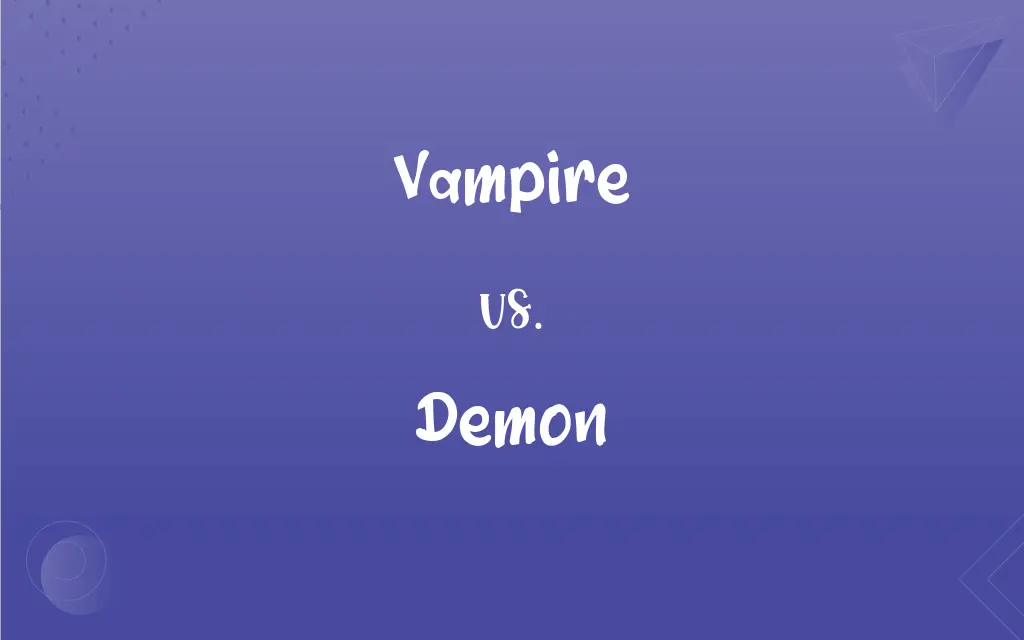Vampire vs. Demon: What's the Difference?
Edited by Janet White || By Harlon Moss || Updated on November 6, 2023
Vampires are undead beings that feed on blood, while demons are supernatural entities often embodying evil.

Key Differences
Vampires are mythological creatures known for their immortality and need to consume blood to survive, often depicted as humans with fangs. They are said to be undead beings that rise from the grave during the night to feed on the living. Demons, in contrast, are often depicted as malevolent spirits or deities from various religious and mythological traditions, and are not confined to a physical body or sustenance like blood.
Vampire legends primarily originate from European folklore, where these creatures are often portrayed as aristocratic and seductive, stalking the night for their prey. Demons, on the other hand, are a more global phenomenon, appearing in cultures all around the world, and their portrayals vary widely, from mischievous spirits to agents of pure evil.
Vampires have specific mythological attributes, such as being repelled by garlic, having no reflection, or being vulnerable to sunlight and wooden stakes. Demons do not have such universal traits and are often depicted with a wide array of powers and forms, frequently associated with possession and the ability to grant dark wishes.
In contemporary media, vampires are often the primary antagonists or antiheroes in horror and fantasy genres, characterized by their interactions with humans and other supernatural creatures. Demons are also prevalent in media but are more diverse in their roles, ranging from the embodiment of sins to complex characters who challenge the boundaries between good and evil.
While vampires have a more defined and consistent folklore that dictates their strengths and weaknesses, demons are a broader category, not restricted to one specific lore or set of characteristics, embodying various aspects of the supernatural across different cultures and stories.
ADVERTISEMENT
Comparison Chart
Origin
European folklore
Global religious and mythological traditions
Nature
Undead, blood-sucking
Supernatural, often malevolent
Physical Form
Human-like, fanged
Variable, often monstrous or ethereal
Weaknesses
Garlic, sunlight, stakes
Holy symbols, exorcism, sacred rituals
Cultural Representation
Often aristocratic, seductive
Wide-ranging, from evil to mischievous
ADVERTISEMENT
Vampire and Demon Definitions
Vampire
A mythological undead being said to arise from the grave at night to drink the blood of the living by biting their necks with long canine teeth.
Ancient lore spoke of a vampire who terrorized the village every full moon.
Demon
An evil spirit or devil, especially one thought to possess a person or act as a tormentor in hell.
The priest believed the tormented man was possessed by a demon.
Vampire
In modern fiction, a charismatic and sophisticated undead being with a complex society and moral code.
The vampire in the novel was torn between his love for a human and his predatory nature.
Demon
A forceful, fierce, or skillful performer of a specified activity.
She was a demon on the basketball court, outplaying all her opponents.
Vampire
A creature that subsists by feeding on the vital essence (usually in the form of blood) of living creatures.
The vampire vanished into the night after feeding on its unsuspecting victim.
Demon
An inner or attendant spirit or inspiring force.
In his solitude, he wrestled with his demons of guilt and regret.
Vampire
A metaphor for a person who preys on others, exhausting their resources or well-being.
He was a financial vampire, draining his clients of their life savings.
Demon
A source or agent of evil, harm, distress, or ruin.
Unchecked ambition was his demon, leading to his downfall.
Vampire
An entity in various popular cultures, often portrayed with supernatural powers and vulnerabilities to certain objects or rituals.
In the movie, the vampire could only be killed by a wooden stake through the heart.
Demon
In mythology, a being of various forms, often represented as dark and malevolent.
Tales were told of a demon that lurked in the ancient woods, preying on travelers.
Vampire
In popular folklore, an undead being in human form that survives by sucking the blood of living people, especially at night.
Demon
An evil supernatural being; a devil.
Vampire
A person, such as an extortionist, who takes advantage of others, especially for personal gain.
Demon
A persistently tormenting person, force, or passion
The demon of drug addiction.
FAQs
Can vampires go out in daylight?
Folklore often suggests vampires are harmed or weakened by sunlight.
What is a demon?
A demon is a supernatural being, typically associated with evil, prevalent in various religions and mythologies.
Can demons possess people?
In many traditions, demons are believed to have the power to possess or influence humans.
What is a vampire?
A vampire is a mythical undead creature that feeds on the blood of the living.
Do vampires have supernatural powers?
Yes, vampires are often portrayed with supernatural abilities like enhanced strength and speed.
What is demonology?
Demonology is the study of demons or beliefs about demons.
How can one become a vampire?
Myths vary, but common lore suggests a person becomes a vampire through the bite of another vampire.
Are there different types of demons?
Yes, there are many types of demons with various attributes across different cultures.
Are vampires considered demons?
While vampires are undead, they are not typically categorized as demons, which are more spiritual or hellish entities.
How can one kill a vampire?
Traditional methods include a stake through the heart, decapitation, or burning.
Are vampires immortal?
In most folklore, vampires are considered immortal unless killed by specific means.
Can demons be good?
In some cultures, there are benevolent spirits or demons that are not evil.
What is the origin of vampire myths?
Vampire myths likely originated from various cultural practices surrounding death and misunderstanding of decomposition processes.
Do vampires age?
Vampires are typically depicted as ageless and maintaining the appearance they had at the time of their turning.
Can vampires enter a home uninvited?
Many myths state that vampires cannot enter a home unless invited by the occupant.
Is exorcism always successful against demons?
In lore and religious beliefs, exorcism is not always guaranteed to work, depending on the demon's strength.
What are common ways to repel demons?
Religious symbols, sacred texts, and rituals like exorcism are believed to repel demons.
Are demons always depicted as malevolent?
While often portrayed as evil, some cultures have more nuanced views of demons.
Do vampires have reflections?
Folklore often holds that vampires do not have reflections in mirrors.
What purpose do demons serve in stories and myths?
Demons typically serve as symbols of evil, challenges to be overcome, or representations of internal struggle.
About Author
Written by
Harlon MossHarlon is a seasoned quality moderator and accomplished content writer for Difference Wiki. An alumnus of the prestigious University of California, he earned his degree in Computer Science. Leveraging his academic background, Harlon brings a meticulous and informed perspective to his work, ensuring content accuracy and excellence.
Edited by
Janet WhiteJanet White has been an esteemed writer and blogger for Difference Wiki. Holding a Master's degree in Science and Medical Journalism from the prestigious Boston University, she has consistently demonstrated her expertise and passion for her field. When she's not immersed in her work, Janet relishes her time exercising, delving into a good book, and cherishing moments with friends and family.































































